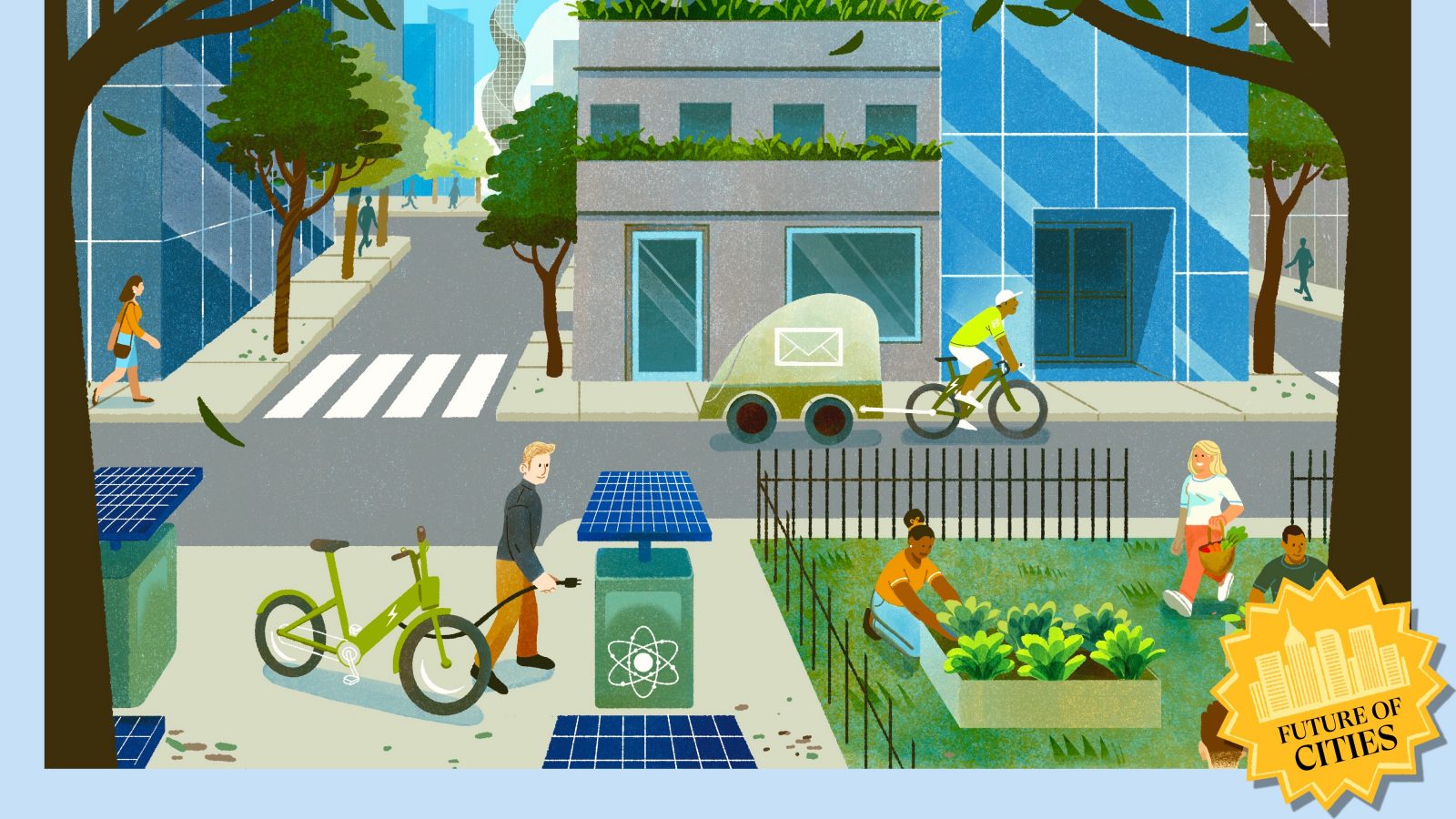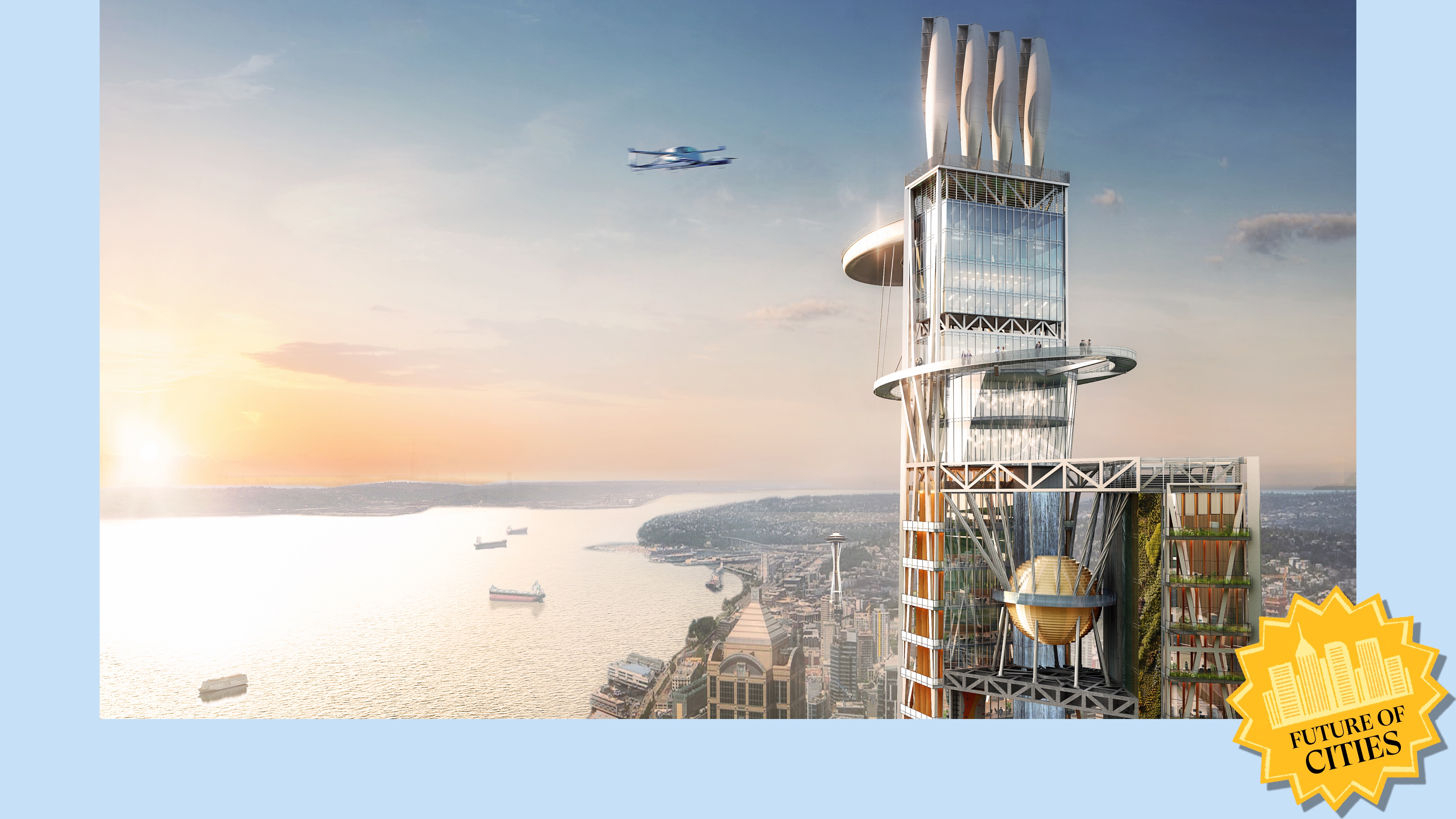As the climate changes, cities must change with it. Fix is exploring how our urban centers are being reimagined and what green, equitable, and resilient communities could look like. With insights from local officials, architects, residents, and more, our Sustainable Cities of the Future series examines how we’ll live, work, and play in the cities of tomorrow. (Explore the full series.)
When the people driving solutions to the climate crisis imagine the future their work could achieve, what do they see? Not the stereotypical sci-fi world of flying cars and aliens, but the real end game for the policies and practices they’re working toward.
From a world without borders to food on every street to a complete rethinking of clean energy incentives, some of them have ready answers, while others have never been asked to look that far ahead and put their visions in words. But all of their ideas could radically change the way you think about climate solutions.
And these big dreams matter. The climate crisis, and the many injustices it encompasses, is so gargantuan that at times it can be difficult to see a way forward. But a clear, compelling vision of the future can be what motivates and inspires people to make changes — even incremental ones — today.
Cities, which will be home to nearly 70 percent of the world’s population by 2050, are fertile ground to experiment with building a more just, more sustainable future. So far in our series on sustainable cities of the future, we’ve explored how that future may take the form of mixed-use skyscrapers constructed with timber. It may be built on policies that draw from the expertise of community members and use equity as a measure for success. Maybe it’ll even involve a sentient AI optimizing a city’s electric grid and enabling energy sovereignty. (Hey, we said maybe.)
To wrap up the series, we asked a handful of experts from different fields a simple (not) question: In the best possible scenario of the next 100 years, what does the clean, green, just city of the future look like to you? We encouraged each person to dream big, and show us a glimpse of the future they’re engaged in building today. Their ideas collectively present a world where resources are shared and valued, people spend less time working and more time engaged in art and community, buildings last for centuries, and cars are a thing of the past. Here are some of their visions, and their voices, lightly edited for length and clarity.
Electrons are valued and traded like money
Mark Chambers is an architect and senior director for building emissions at the White House Council on Environmental Quality. He previously led the local sustainability offices in D.C. and New York City.
We need to start thinking about electrons as currency.
I know that may sound strange, but as we start to recognize and change our value proposition for clean electricity and clean energy, we have to give it its fair value and look at how we exchange clean electrons from the solar on our roof to a battery, to our appliances in our kitchen, to our vehicle outside. Electrons become a part of this currency model, which I think is important because then we give it the value it deserves. Clean electrons should have appropriate value. And I think then we’ll start to see the development of tech that speaks to that.
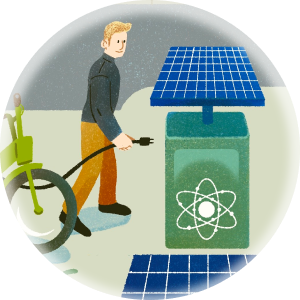 Lots of things are going to have to be flexible and interchangeable to make that city of the future work well. I imagine much more of a Lego city that allows us to pull and move parts that make it adaptable to our needs at the time. Part of how you do that is by designing things in components and thinking about how things are used, how they’re replaced, how we’re not designing for obsolescence but we’re designing for reuse and retooling and then reuse again. I’d love to see that Lego future city that is built on a framework of equal access.
Lots of things are going to have to be flexible and interchangeable to make that city of the future work well. I imagine much more of a Lego city that allows us to pull and move parts that make it adaptable to our needs at the time. Part of how you do that is by designing things in components and thinking about how things are used, how they’re replaced, how we’re not designing for obsolescence but we’re designing for reuse and retooling and then reuse again. I’d love to see that Lego future city that is built on a framework of equal access.
Green buildings last for centuries
Joseph Kunkel is an architect and director of MASS Design Group’s Sustainable Native Communities Design Lab.
What does it mean to be building carbon-positive buildings? What does it mean for buildings to be giving back to the earth rather than taking?
Far too often, we’re thinking about the bottom line, or we’re thinking about the lowest costs, or how to continue to make “affordable housing” cheaper to build. When I think about it more holistically, if we’re really truly investing in affordable housing, it’s not just about the dollars and cents. We need to be thinking critically about the lifespan of the buildings that we build. Because the longest phase of a [building] project is its operation and maintenance. It’s not the predevelopment, it’s not the design phase, it’s not the construction phase, but it’s how long people are living in buildings. If we were to readjust how we think about costs, I think we would be investing more dollars and cents into our buildings rather than having to try and hit the lowest common denominator.
And if we think about it that way, we can start to think about what does a building that lasts for 250, 300 years look like? How do we [build] that in a way that is then giving back to the earth and giving back to all living things?
Concrete is a high-energy, nonrenewable material. There’s a lot of embodied carbon in concrete. And yet we continue to use it every day in the buildings that we build. If we hearken back to some of the first Indigenous buildings here in the Southwest, we see stone foundations, or compressed earth block foundations.
A city is this complex working system of many pieces coming together to make it successful. I always go back to: How have we learned in the past? Much of our work is about our Indigenous populations who have lived in dense places or dense cities historically; we think about the Hohokam community, who lived in what is now the Phoenix valley, how they lived in this kind of dense structure and didn’t have to sprawl out. I think we can learn a lot from our historic Indigenous patterns, and then apply those methods and ways of thinking to our cities.
Common goods unite us
Amali Tower is the founder and executive director of humanitarian advocacy group Climate Refugees.
I’m totally imagining just tons of green space. Open borders. Accessible and available public services, regardless of status, regardless of nationality, residency, et cetera. Governance that’s based on power sharing between different populations. Moving away from nation systems.
It’s all centered and built around a common identity and a common humanity. That’s what really grounds the fact that there’s no need for securitized border control. And for me, that doesn’t create chaos. I see order. I see the free flow of ideas, the passage of goods.
When there’s no shortage, there’s no want. Instead, there’s an egalitarian principle of this common, shared humanity of space — our common city, our common transport, our common public goods. And redefining what all these concepts and terms actually mean for us dispels a lot of the ways we think today that silo the way we treat one another [based on borders and property].I see this all coming about in 100 years or so because we actually accepted the concept of differentiated responsibilities today. We accepted that we’re in the situation we’re in now because certain countries have developed at the expense of others. And we finally took responsibility for that by saying, “I have a differentiated responsibility as a result.” And in doing so, there’s this reconciliation that happens because there’s accountability. Maybe that sounds idealistic and even naive to somebody, but I just spelled out something that actually exists in international law and policy. So if we wanted to, we could execute it.
Cars are a thing of the past
Melinda Hanson is cofounder of the clean-transit consulting group Electric Avenue.
The city of the future looks like a place with much more equitable distribution of space — far fewer miles of road given over to asphalt and free car parking, and a much better use of our public spaces for leisure and for play and for storing of shared electric vehicles.
I think a lot of people who are in this electric mobility space want to be excited about the electric Ford F-150 and the electric Hummer — it’s great to move people to electric vehicles, but it does signal a lack of understanding that the problem is not just the fuel source. The problem is the space, the problem is congestion and noise. And so a lot of the solutions are going to be about reducing the size of these vehicles. The micromobility revolution is only just beginning.
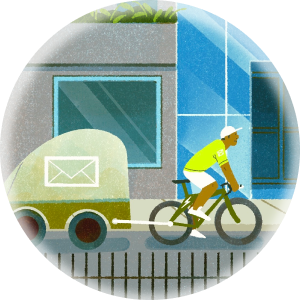 If you look at what’s coming in the electric vehicle space, there’s all kinds of smaller modes — ones that basically are the footprint of an e-bike but are actually enclosed, so you can have temperature regulation. Ones that have massive cargo ability, so they can actually replace these huge UPS trucks in certain places around cities.
If you look at what’s coming in the electric vehicle space, there’s all kinds of smaller modes — ones that basically are the footprint of an e-bike but are actually enclosed, so you can have temperature regulation. Ones that have massive cargo ability, so they can actually replace these huge UPS trucks in certain places around cities.
I keep thinking about how one of the things that people really remarked on in New York City during the pandemic was how quiet everything was, when everything shut down and people stopped moving around. How you could hear the birds, and how it was so much nicer to walk around the city. Of course, behind the scenes there was a lot of heartache and economic distress happening. But I think what was shown about what the soundscape of a city is like when you take some cars away, another future — and a better one — is possible.
People lead more balanced lives
Linda Cheung is an artist and activist. She founded the nonprofit creative lab Before It’s Too Late, using projects like augmented reality-enhanced murals to engage the public around climate action.
We’re becoming more aware of how important it is to bring back that local community — because so many of us feel disconnected and lonely. People are looking into new types of structures for living — so not just a nuclear family and white picket fence. For a while, we’ve been building this American dream, and that vision is going to change.
On one hand, we’re in the mode of “we need to conserve and we need to bring back some of these old values that we’ve lost touch with.” But on the other hand, there are some big changes that are going to happen. There are many different fields in development right now, like AI, and that might change humans being the sole processing power. Who knows what AI can achieve for us in terms of solutions? We’re already starting to think about stuff like universal basic income, because we realize that maybe the role of the human in society is changing. Maybe it’s not our job to just keep working more and more, but rather, now that we’ve developed all this, how can we find a way to share that surplus that we’ve created and allow humans to live a more balanced life?
Art has and will always play a huge role in society. I think the arts help people to think differently and remember what’s most important. I know that public art will continue and may start taking new forms. I hope that artists continue to thrive and help society in reminding us of these bigger questions of what we want for human existence.
Food grows instead of lawns
Ron Finley is an L.A.-based food-justice advocate, designer, and “gangsta gardener.” He is a proponent of planting in public spaces like medians and abandoned lots, sometimes known as guerilla gardening.
It looks like freedom.
I want to see people more engaged in Mother Nature, because if you heal your mother, you heal yourself. We have to realize that we are a part of this planet. It’s not the planet and then us. We decompose just like a leaf does.
What I want to see is kids educated — and not indoctrinated — about what’s truly important in this world. To see air as a resource, to see soil as a resource, to see water as not just something that goes on and on. I want to see people utilizing all the resources around them just like the planet does, in a way that’s regenerative.
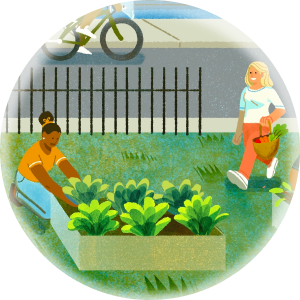 You go to the supermarket and you see all the shelves are stocked and full, everything looks so abundant — and it’s truly not. But can it be? Yes, if we get to a point where we start growing a lot of our own food collectively with our neighbors. There should be food on all the streets throughout the world. There should be food growing instead of grass.
You go to the supermarket and you see all the shelves are stocked and full, everything looks so abundant — and it’s truly not. But can it be? Yes, if we get to a point where we start growing a lot of our own food collectively with our neighbors. There should be food on all the streets throughout the world. There should be food growing instead of grass.
Here in L.A., I got the law changed where you can grow food on the street. They didn’t tell nobody, or advocate for it, or put up bulletin boards, but it’s changed. I think the people that enforce the law don’t even know that it’s been changed, because I get a lot of phone calls from people, like, “What should I do? They gave me a citation for my tomatoes on the street.”
All of this that we’re dealing with is manmade, and it can be fixed, too. Let’s move some of this asphalt and put in some parks, put in some trees, put in some green space, and have an appreciation and acknowledgement and respect and reverence for this beautiful planet that we’re on.
Explore more in our series on Sustainable Cities of the Future:
>> These 5 people are building the green cities of the future
>> What big cities can learn about climate adaptation from rural Louisiana
>> Too many clean energy programs leave the poor behind. Enter the ‘equity map.’
>> A more sustainable skyscraper? Imagine a ‘spaceship designed by Jenga.’
>> Will climate-friendly cities be friendly to climate migrants?

